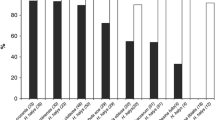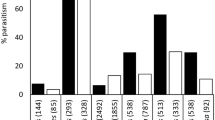Abstract
The invasive stink bug Halyomorpha halys, native to East Asia, is a severe agricultural pest of worldwide importance, and chemical insecticides are largely sprayed for its control. Negative impact and failures of chemical pest management led to consider classical biological control as one of the most promising methods in a long-term perspective. The Asian egg parasitoid Trissolcus japonicus is the main candidate biocontrol agent of H. halys, but more recently a second species, Trissolcus mitsukurii, which shares the area of origin with H. halys, has drawn special attention after adventive populations were found in Europe. Despite its recent detection, intentional release or redistribution are bound to approval of national petitions, which requires detailed risk analyses. With the aim of providing a contribution for the future development of a risk assessment for release purposes, here we present the first study on the physiological (fundamental) host range of T. mitsukurii in Europe. Tests conducted on different hemipterans common to Southern Europe, using three different experimental designs, revealed a oligophagous host range, limited to Pentatomoidea and comparable with the host range displayed by T. japonicus under similar laboratory conditions. In addition to its coevolved host H. halys, T. mitsukurii successfully parasitized the majority of tested pentatomid species and one scutellerid, although with highly variable emergence rates. Notably high parasitization rates were detected on H. halys, Acrosternum heegeri and Dolycoris baccarum. Host egg sizes positively affected parasitoid size and female egg load. Although T. mitsukurii might be a promising biological control agent of H. halys in Europe, further studies (e.g., chemical ecology, field parasitism) are needed for assessment of non-target risks.




Similar content being viewed by others
Availability of data and material
Available under request to the corresponding author.
Code availability
Not applicable.
References
Abram PK, Gariepy TD, Boivin G, Brodeur J (2014) An invasive stink bug as an evolutionary trap for an indigenous egg parasitoid. Biol Invasion 16:1387–1395
Abram PK, Parent JP, Brodeur J, Boivin J (2016) Size-induced phenotypic reaction norms in a parasitoid wasp: an examination of life-history and behavioural traits. Biol J Linn Soc 117:620–632
Abram PK, Hoelmer KA, Acebes-Doria A et al (2017) Indigenous arthropod natural enemies of the invasive brown marmorated stink bug in North America and Europe. J Pest Sci 90:1009–1020
Abram PK, Mills NJ, Beers EH (2020) Review: classical biological control of invasive stink bugs with egg parasitoids—What does success look like? Pest Manag Sci 76:1980–1992
Arakawa R, Miura M, Fujita M (2004) Effects of host species on the body size, fecundity, and longevity of Trissolcus mitsukurii (Hymenoptera: Scelionidae), a solitary egg parasitoid of stink bugs. Appl Entomol Zool 39:177–181
Arakawa R, NamuraY, (2002) Effects of temperature on development of three Trissolcus spp. (Hymenoptera: Scelionidae), egg parasitoids of the brown marmorated stink bug, Halyomorpha halys (Hemiptera: Pentatomidae). Entomol Sci 5:215–218
Benvenuto L, Bernardinelli I, Malossini G, Sabbatini Peverieri G, Marianelli L, Roversi PF (2020) Monitoraggio di ovature parassitizzate di Halyomorpha halys in un actinidieto biologico in Friuli Venezia Giulia nel biennio 2018–2019. Atti Giornate Fitopatologiche 1:161–166
Bertoldi V, Rondoni G, Brodeur J, Conti E (2019) An egg parasitoid efficiently exploits cues from a coevolved host but not those from a novel host. Front Physiol 10:746. https://doi.org/10.3389/fphys.2019.00746
Botch PS, Delfosse ES (2018) Host-acceptance behavior of Trissolcus japonicus (Hymenoptera: Scelionidae) reared on the invasive Halyomorpha halys (Heteroptera: Pentatomidae) and nontarget species. Environ Entomol 47:403–411
Boyle SM, Weber DC, Hough-Goldstein J, Hoelmer KA (2020) Host kairomones influence searching behavior of Trissolcus japonicus (Hymenoptera: Scelionidae), a parasitoid of Halyomorpha halys (Heteroptera: Pentatomidae). Environ Entomol 49(1):15–20. https://doi.org/10.1093/ee/nvz155
Charles JG, Avila GA, Hoelmer KA, Hunt S, Gardner-Gee R, MacDonald F, Davis V (2019) Experimental assessment of the biosafety of Trissolcus japonicus in New Zealand, prior to the anticipated arrival of the invasive pest Halyomorpha halys. Biocontrol 64:367–379. https://doi.org/10.1007/s10526-019-09949-x
Chu F-J, Zhou Z-F, Li R-P, Liu X-C (1997) Study on control and observation of the bionomics characteristics of Halyomorpha picus Fabricius. J Agric Univ Hebei 20:12–17
Conti E, Avila G, Barratt B, Cingolani F, Colazza S, Guarino S, Hoelmer K, Laumann RA, Maistrello L, Martel G et al (2021) Biological control of invasive stink bugs: review of global state and future prospects. Ent Exp Appl 169(1):28–51
EPPO (2014) PM 6/2 (3) Import and release of non-indigenous biological control Agents. Bulletin OEPP/EPPO Bulletin 44(3):320–329
FAO-IPPC (2017) ISPM 3 Guidelines for the export, shipment, import and release of biological control agents and other beneficial organisms. www.ippc.int
Haye T, Moraglio ST, Stahl J, Visentin S, de Gregorio T, Tavella L (2019) Fundamental host range of Trissolcus japonicus in Europe. J Pest Sci 93:171–182. https://doi.org/10.1007/s10340-019-01127-3
Hedstrom C, Lowenstein D, Andrews H, Bai B, Wiman N (2017) Pentatomid host suitability and the discovery of introduced populations of Trissolcus japonicus in Oregon. J Pest Sci 90:1169–1179
Hokyo N, Kiritani K, Nakasuji F, Shiga M (1966) Comparative biology of the two scelionid egg parasites of Nezara viridula L. (Hemiptera: Pentatomidae). Jpn J Appl Entomol Z 1:94–102
Hokyo N, Kiritani K (1963) Two species of egg parasites as contemporaneous mortality factors in the egg population of the southern green stink bug, Nezara viridula. Jpn J Appl Entomol Z 7:214–226
Hunt E, Kuhlmann U, Sheppard A, Qin TK, Barratt BIP, Harrison L, Mason PG, Parker D, Flanders RV, Goolsby J (2008) Review of invertebrate biological control regulation in Australia, New Zealand, Canada and the USA: recommendations for a harmonized European system. J Appl Entomol 132:89–123
Kiritani K, Hokyo N (1962) Studies on the life table of the southern green stink bug, Nezara viridula. Jpn J Appl Entomol Z 6:124–140
Kuhlmann U, Mason PG (2003) Use of field host range surveys for selecting candidate non-target species for physiological host specificity testing of entomophagous biological control agents. In: 1st International Symposium on Biological Control of Arthropods, Honolulu, Hawaii, USA, January 14–18, 2002. USDA Forest Service FHTET-03–05, pp. 370–377.
Kuhlmann U, Schaffner U, Mason PG (2006) Selection of non-target species for host specificity testing. In: Bigler F, Babendreier D, Kuhlmann U (eds) Environmental impact of invertebrates for biological control of arthropods: methods and risk assessment. CAB International, pp 15–37.
Lara JR, Pickett CH, Kamiyama MT, Figueroa S, Romo M, Cabanas C, Bazurto V, Strode V, Briseno K, Lewis M, Oliva J, Hernandez G, Hoddle MS (2019) Physiological host range of Trissolcus japonicus in relation to Halyomorpha halys and other pentatomids from California. Biocontrol 64:513–528
Leskey TC, Nielsen AL (2018) Impact of the invasive brown marmorated stink bug in North America and Europe: History, biology, ecology, and management. Ann Rev Entomol 63:599–618
Milnes J, Beers E (2019) Trissolcus japonicus (Hymenoptera: Scelionidae) causes low levels of parasitism in three north american pentatomids under field conditions. J Insect Sci 19(4):15. https://doi.org/10.1093/jisesa/iez074
Rondoni G, Bertoldi V, Malek R, Djelouah K, Moretti C, Buonaurio R, Conti E (2018) Vicia faba plants respond to oviposition by invasive Halyomorpha halys activating direct defences against offspring. J Pest Sci 91(2):671–679
Rondoni G, Bertoldi V, Malek R, Foti MC, Peri E, Maistrello L, Haye T, Conti E (2017) Native egg parasitoids recorded from the invasive Halyomorpha halys successfully exploit volatiles emitted by the plant–herbivore complex. J Pest Sci 90(4):1087–1095
Ryu J, Hirashima Y (1984) Taxonomic studies on the genus Trissolcus Ashmead of Japan and Korea (Hymenoptera, Scelionidae). J Faculty Agric Kyushu Univ 29:35–58
Sabbatini Peverieri G, Boncompagni L, Mazza G, Paoli F, Dapporto L, Giovannini L, Marianelli L, Hoelmer K, Roversi PF (2021) Combining physiological host range, behavior and host characteristics for predictive risk analysis of Trissolcus japonicus. J Pest Sci. https://doi.org/10.1007/s10340-020-01311-w
Sabbatini Peverieri G, Talamas E, Bon MC, Marianelli L, Bernardinelli I, Malossini G, Benvenuto L, Roversi PF, Hoelmer K (2018) Two Asian egg parasitoids of Halyomorpha halys (Stal) (Hemiptera, Pentatomidae) emerge in northern Italy: Trissolcus mitsukurii (Ashmead) and Trissolcus japonicus (Ashmead) (Hymenoptera, Scelionidae). J Hym Res 67:37–53. https://doi.org/10.3897/jhr.67.30883
Sabbatini Peverieri G, Dieckhoff C, Giovannini L, Marianelli L, Roversi PF, Hoelmer K (2020) Rearing Trissolcus japonicus and Trissolcus mitsukurii for Biological Control of Halyomorpha halys. Insects 11:787. Doi: https://doi.org/10.3390/insects11110787
Scaccini D, Falagiarda M, Tortorici F, Martinez-Sañudo I, Tirello P, Reyes-Domínguez Y, Gallmetzer A, Tavella L, Zandigiacomo P, Duso C, Pozzebon A (2020) An Insight into the Role of Trissolcus mitsukurii as Biological Control Agent of Halyomorpha halys in Northeastern Italy. Insects. Doi: https://doi.org/10.3390/insects11050306
Stahl J, Tortorici F, Pontini M, Bon MC, Hoelmer K, Marazzi C, Tavella L, Haye T (2019) First discovery of adventive populations of Trissolcus japonicus (Ashmead) in Europe. J Pest Sci 92:371–379. Doi: https://doi.org/10.1007/s1034 0–018–1061–2
Talamas EJ, Herlihy MV, Dieckhoff C, Hoelmer KA, Buffington ML, Bon M-C, Weber DC (2015) Trissolcus japonicus (Ashmead) (Hymenoptera, Scelionidae) emerges in North America. J Hym Res 43:119–128. https://doi.org/10.3897/JHR.43.4661
van Lenteren JC, Bale J, Bigler F, Hokkanen HMT, Loomans AJM (2006a) Assessing risks of releasing exotic biological control agents of arthropod pests. Annu Rev Entomol 51:609–634
van Lenteren JC, Cock MJW, Hoffmeister TS, Sands DPA (2006b) Host specificity in arthropod biological control, methods for testing and interpretation of the data. In: Bigler F, Babendreier D, Kuhlmann U (eds) Environmental impact of invertebrates for biological control of arthropods: methods and risk assessment. CAB International, pp. 38–63.
Yang Z-Q, Yao Y-X, Qiu L-F, Li Z-X (2009) A new species of Trissolcus (Hymenoptera: Scelionidae) parasitizing eggs of Halyomorpha halys (Heteroptera: Pentatomidae) in China with comments on its biology. Ann Entomol Soc Am 102:39–47
Yasumatsu K, Watanabe C (1964) A tentative catalogue of insect natural enemies of injurious insects in Japan—part 1. Parasite-Predator Host Catalogue. Fukuoka, Japan: Entomological Laboratory, Faculty of Agriculture Kyushu University
Zapponi L, Bon MC, Fouani JM, Anfora G, Schmidt S, Falagiarda M (2020) Assemblage of the egg parasitoids of the invasive stink bug Halyomorpha halys: insights on plant host associations. Insects. https://doi.org/10.3390/insects11090588
Zapponi L, Tortorici F, Anfora G, Bardella S, Bariselli M, Benvenuto L, Bernardinelli I, Butturini A, Caruso S, Colla R, Costi E, Culatti P, Di Bella E, Falagiarda M, Giovannini L, Haye T, Maistrello L, Malossini G, Marazzi C, Marianelli L, Mele A, Michelon L, Moraglio ST, Pozzebon A, Preti M, Salvetti M, Scaccini D, Schmidt S, Szalatnay D, Roversi PF, Tavella L, Tommasini MG, Vaccari G, Zandigiacomo P, Sabbatini-Peverieri G (2021) Assessing the distribution of exotic egg parasitoids of Halyomorpha halys in Europe with a large-scale monitoring program. Insects 12(4):316. https://doi.org/10.3390/insects12040316
Zhang J, Zhang F, Gariepy T, Mason P, Gillespie D, Talamas E, Haye T (2017) Seasonal parasitism and host specificity of Trissolcus japonicus in northern China. J Pest Sci 90:1127–1141
Acknowledgements
We are grateful to Iris Bernardinelli, Giorgio Malossini and Luca Benvenuto of ERSA Friuli Venezia Giulia, and to Giacomo Vaccari and Stefano Caruso of the Consorzio Fitosanitario Modena for the help in the field collection of H. halys in infested sites in northern Italy. We thank Riccardo Frosinini, Andrea Rocchini, Paolo Toccafondi, Tiziano Fabbricatore and Luca Madonni for assistance in H. halys and non-target species rearing in the laboratory. This work was supported by the Ministero per le Politiche Agricole, Alimentari e Forestali (MiPAAF), projects “Salvaolivi” (DM 0033437 21/12/2017) and “Proteggo 1.3” (MIPAAF DISRV 0155972 6/04/2021).
Funding
This research was founded by the Ministero delle Politiche Agrarie Alimentari e Forestali.
Author information
Authors and Affiliations
Corresponding author
Ethics declarations
Conflicts of interest
The authors declare no conflict of interest.
Ethics approval
This article does not contain any studies with human participants or vertebrates performed by any of the authors.
Additional information
Communicated by Antonio Biondi .
Publisher's Note
Springer Nature remains neutral with regard to jurisdictional claims in published maps and institutional affiliations.
Supplementary Information
Below is the link to the electronic supplementary material.
Rights and permissions
About this article
Cite this article
Giovannini, L., Sabbatini-Peverieri, G., Marianelli, L. et al. Physiological host range of Trissolcus mitsukurii, a candidate biological control agent of Halyomorpha halys in Europe. J Pest Sci 95, 605–618 (2022). https://doi.org/10.1007/s10340-021-01415-x
Received:
Revised:
Accepted:
Published:
Issue Date:
DOI: https://doi.org/10.1007/s10340-021-01415-x




